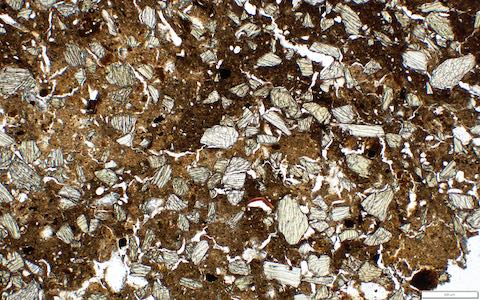
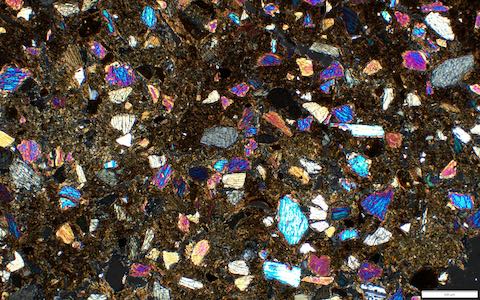
| None (0) | Minor (1) | Few (2) | Common (3) | Frequent (4) | Major (5) | Very Dominant (6) |
| 0% | 0-5% | 5-15% | 15-30 % | 30-50% | 50-70% | 70-100% |
| Name | Cal. | Quartz | Feldspar | Pyroxene | Amphibole | Opaques | Olivine | Biotite | Muscovite | Epidote | Garnet/ Spinel | Ig./Met. Rocks | Sed. Rocks | Grog | Lithics/ Region |
|---|---|---|---|---|---|---|---|---|---|---|---|---|---|---|---|
| tpr179a | 1 | 0 | 1 | 1 | 0 | 2 | 0 | 0 | 0 | 0 | 0 | 0 | 0 | 6 | microlitic |
| Huon grog | 0 | 0 | 0 | 0 | 0 | 0 | 0 | 0 | 0 | 0 | 0 | 0 | 0 | 6 | PNG |
| tpr274 | 1 | 1 | 3 | 6 | 1 | 2 | 0 | 0 | 0 | 0 | 0 | 3 | 0 | 0 | vitric, microlitic, lathwork |
| Huon pyroxenic | 0 | 0 | 1 | 5 | 0 | 0 | 0 | 0 | 0 | 0 | 0 | 1 | 0 | 0 | PNG |
| tpr300 | 0 | 0 | 1 | 1 | 0 | 6 | 0 | 0 | 0 | 0 | 0 | 1 | 0 | 1 | microlitic |
| Huon ferruginous | 0 | 0 | 0 | 0 | 0 | 6 | 0 | 0 | 0 | 0 | 0 | 0 | 0 | 0 | PNG |
| tpr458 | 6 | 2 | 2 | 2 | 0 | 1 | 0 | 0 | 0 | 0 | 0 | 0 | 0 | 0 | na |
| Huon calcareous | 5 | 0 | 1 | 0 | 0 | 1 | 0 | 0 | 0 | 0 | 0 | 0 | 0 | 0 | PNG |
| tpr459 | 2 | 2 | 3 | 4 | 0 | 3 | 0 | 0 | 0 | 0 | 0 | 4 | 0 | 0 | microphaneritic, microlitic, vitric |
| Madang pyroxenic lithic | 0 | 0 | 2 | 3 | 0 | 2 | 0 | 0 | 0 | 0 | 0 | 3 | 0 | 0 | PNG |
| tpr460 | 0 | 2 | 5 | 2 | 0 | 1 | 0 | 0 | 0 | 0 | 0 | 4 | 0 | 0 | microlitic, microphaneritic |
| Madang feldspathic lithic | 0 | 0 | 4 | 1 | 0 | 1 | 0 | 0 | 0 | 0 | 0 | 3 | 0 | 0 | PNG |
| tpr461 | 4 | 0 | 5 | 0 | 0 | 1 | 0 | 0 | 0 | 0 | 0 | 2 | 0 | 0 | microphaneritic, microlitic |
| Madang feldspathic hybrid | 1 | 0 | 2 | 0 | 0 | 1 | 0 | 0 | 0 | 0 | 0 | 2 | 0 | 0 | PNG |
| tpr483 | 0 | 1 | 5 | 4 | 0 | 1 | 0 | 2 | 0 | 0 | 0 | 4 | 0 | 0 | microlitic, lathwork, microphaneritic, plutonite |
| Huon feldspathic lithic | 0 | 0 | 4 | 1 | 0 | 1 | 0 | 1 | 0 | 0 | 0 | 2 | 0 | 0 | PNG |
| tpr484 | 0 | 4 | 4 | 1 | 0 | 3 | 0 | 0 | 0 | 0 | 0 | 1 | 0 | 0 | plutonite |
| Huon quartzose | 0 | 4 | 4 | 1 | 0 | 3 | 0 | 0 | 0 | 0 | 0 | 1 | 0 | 0 | PNG |
| tpr485 | 0 | 1 | 2 | 3 | 0 | 5 | 0 | 0 | 0 | 0 | 0 | 1 | 0 | 0 | na |
| Madang placer | 0 | 1 | 2 | 3 | 0 | 5 | 0 | 0 | 0 | 0 | 0 | 1 | 0 | 0 | PNG |
| tpr486 | 0 | 2 | 3 | 3 | 1 | 2 | 0 | 0 | 0 | 0 | 0 | 2 | 0 | 0 | microlitic, microphaneritic |
| Huon feldspathic pyroxenic | 0 | 2 | 3 | 3 | 1 | 2 | 0 | 0 | 0 | 0 | 0 | 2 | 0 | 0 | PNG |
| Slide | Fabric | Possible Origin | Cal. | Quartz | Feldspar | Pyroxene | Amphibole | Opaques | Olivine | Biotite | Muscovite | Epidote | Garnet/ Spinel | Ig./Met. Rocks | Sed. Rocks | Grog | Lithics |
|---|---|---|---|---|---|---|---|---|---|---|---|---|---|---|---|---|---|
| IL_1_97 | tpr274 (Huon pyroxenic) | Sio | 0 | 0 | 2 | 6 | 0 | 1 | 0 | 0 | 0 | 0 | 0 | 1 | 0 | 0 | microlitic |
| IL_1_39 | tpr461 (Madang feldspathic hybrid) | Madang | 4 | 0 | 2 | 0 | 0 | 1 | 0 | 0 | 0 | 0 | 0 | 2 | 0 | 0 | microlitic, microphaneritic |
| IL_1_1 | tpr459 (Madang pyroxenic lithic) | Madang | 2 | 0 | 3 | 3 | 0 | 3 | 0 | 0 | 0 | 0 | 0 | 3 | 0 | 0 | microphaneritic |
| IL_1_61 | tpr274 (Huon pyroxenic) | Huon | 0 | 1 | 2 | 6 | 0 | 2 | 0 | 0 | 0 | 0 | 0 | 2 | 0 | 0 | vitric, microlitic |
| IL_1_17 | tpr274 (Huon pyroxenic) | Huon | 0 | 0 | 2 | 6 | 0 | 2 | 0 | 0 | 0 | 0 | 0 | 2 | 0 | 0 | vitric, microlitic |
| IL_1_60 | tpr300 (Huon ferruginous) | Huon | 0 | 0 | 0 | 0 | 0 | 6 | 0 | 0 | 0 | 0 | 0 | 1 | 0 | 0 | microlitic |
| IL_1_38 | tpr459 (Madang pyroxenic lithic) | Madang | 0 | 1 | 3 | 3 | 0 | 2 | 0 | 0 | 0 | 0 | 0 | 3 | 0 | 0 | microphaneritic |
| IL_1_57 | tpr459 (Madang pyroxenic lithic) | Madang | 2 | 2 | 2 | 3 | 0 | 3 | 0 | 0 | 0 | 0 | 0 | 3 | 0 | 0 | microphaneritic |
| IL_1_58 | tpr458 (Huon calcareous) | Huon | 6 | 2 | 2 | 0 | 0 | 1 | 0 | 0 | 0 | 0 | 0 | 0 | 0 | 0 | na |
| IL_1_18 | tpr483 (Huon feldspathic lithic) | Sio | 0 | 1 | 4 | 2 | 0 | 1 | 0 | 2 | 0 | 0 | 0 | 2 | 0 | 0 | microphaneritic |
| IL_1_31 | tpr274 (Huon pyroxenic) | Sio | 0 | 0 | 2 | 5 | 1 | 2 | 0 | 0 | 0 | 0 | 0 | 2 | 0 | 0 | microlitic |
| IL_1_15 | tpr274 (Huon pyroxenic) | Sio | 0 | 0 | 2 | 5 | 0 | 2 | 0 | 0 | 0 | 0 | 0 | 2 | 0 | 0 | microlitic |
| IL_1_12 | tpr274 (Huon pyroxenic) | Sio | 0 | 1 | 1 | 6 | 0 | 1 | 0 | 0 | 0 | 0 | 0 | 2 | 0 | 0 | microphaneritic, microlitic |
| IL_1_66 | tpr274 (Huon pyroxenic) | Sio | 0 | 1 | 1 | 6 | 0 | 1 | 0 | 0 | 0 | 0 | 0 | 1 | 0 | 0 | microlitic, microphaneritic |
| IL_1_63 | tpr274 (Huon pyroxenic) | Sio | 0 | 1 | 1 | 6 | 0 | 1 | 0 | 0 | 0 | 0 | 0 | 1 | 0 | 0 | microlitic, microphaneritic |
| IL_1_55 | tpr484 (Huon quartzose) | Madang | 0 | 4 | 4 | 1 | 0 | 3 | 0 | 0 | 0 | 0 | 0 | 1 | 0 | 0 | plutonite |
| IL_1_37 | tpr485 (Madang placer) | Madang | 0 | 1 | 2 | 3 | 0 | 5 | 0 | 0 | 0 | 0 | 0 | 1 | 0 | 0 | na |
| IL_1_28 | tpr274 (Huon pyroxenic) | Sio | 0 | 1 | 3 | 5 | 0 | 0 | 0 | 0 | 0 | 0 | 0 | 2 | 0 | 0 | microlitic |
| IL_1_68 | tpr486 (Huon feldspathic pyroxenic) | Sio | 0 | 2 | 3 | 3 | 1 | 2 | 0 | 0 | 0 | 0 | 0 | 2 | 0 | 0 | microlitic, microphaneritic |
| IL_1_21 | tpr458 (Huon calcareous) | Madang | 5 | 2 | 2 | 0 | 0 | 1 | 0 | 0 | 0 | 0 | 0 | 0 | 0 | 0 | na |
| IL_1_20 | tpr460 (Madang feldspathic lithic) | Madang | 0 | 2 | 4 | 1 | 0 | 1 | 0 | 0 | 0 | 0 | 0 | 4 | 0 | 0 | microphaneritic, microlitic, lathwork |
| IL_1_6 | tpr460 (Madang feldspathic lithic) | Madang | 0 | 1 | 4 | 2 | 0 | 1 | 0 | 0 | 0 | 0 | 0 | 4 | 0 | 0 | microphaneritic, microlitic, lathwork |
| IL_1_56 | tpr483 (Huon feldspathic lithic) | Sio | 0 | 1 | 4 | 3 | 0 | 1 | 0 | 1 | 0 | 0 | 0 | 3 | 0 | 0 | vitric, lathwork |


CAUTION: Section less than 30microns. Lakakulu clay used by Sio potters. Pyroxene is pale green, angular, and dominates. The clay is brown and contains small feldspar grains, less than 0.1 mm across. There are minor ferruginized clay and feldspar clasts up to 1 mm across. Opaque minerals are small a minority. There is a trace of volcanic rock fragments containing feldspar and small magnetite crystals.
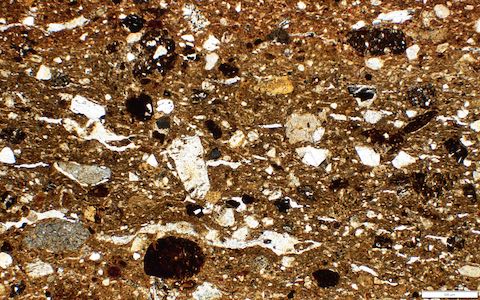
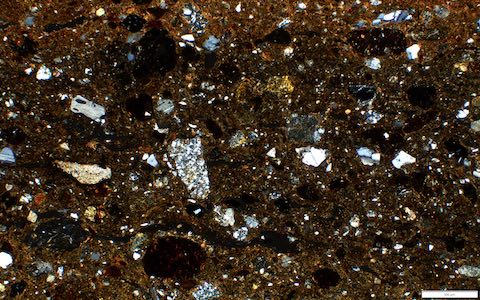
Madang style sherd. CAUTION: Section less than 30microns. Plagioclase (5%), volcanic rock fragments (<5%), ferruginized pellets and accessory shell fragments are all less than 0.6 m in diameter. The clay is red brown and contains abundant fine grained quartz, feldspar and iron oxides.
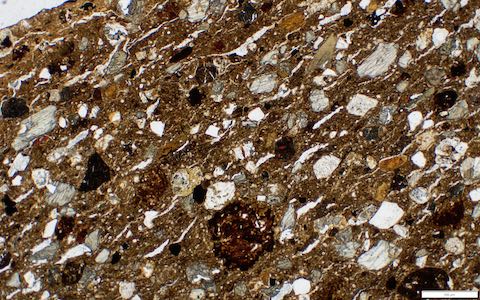
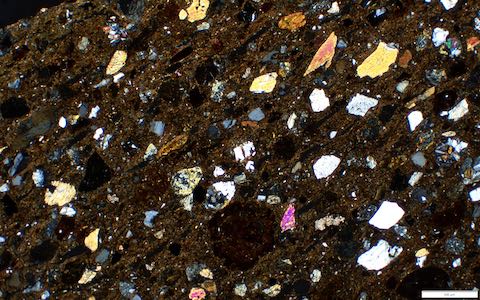
Madang style sherd. "CAUTION: Section less than 30microns. This sherd contains a mixture of shelly fragments, pyroxene, plagioclase , iron oxide and volcanic rock fragments. All these components are present in roughly the same amounts. The grain size rarely exceeds 0.3 mm in length. There are some large clasts made up of ferruginized clay and feldspar. These could be weathered volcanic rock fragments or previous pot fragments. The clay is dark brown.
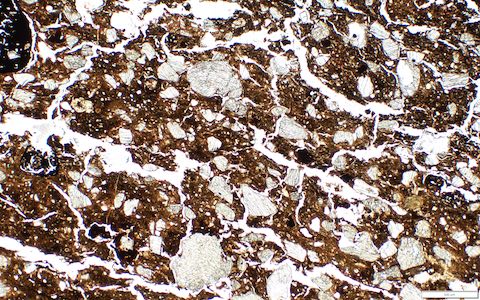
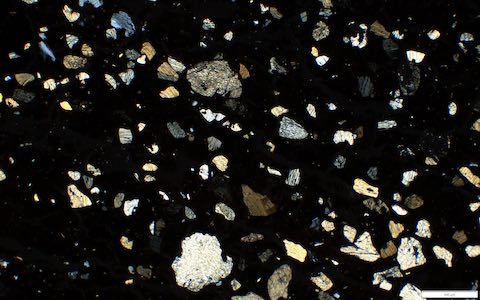
Sio style sherd. CAUTION: Section less than 30microns. Pyroxene grains range in size from 0.1 up to 0.7 mm in length. There are some ferruginized clay pellets, up to 2 mm in length. Minor plagioclase and iron oxide minerals are also present. The sherd also contains abundant fine grained quartz grains, less than 0.1 mm
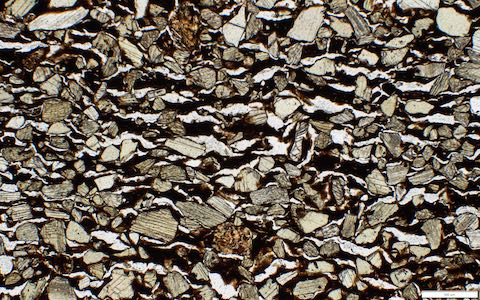
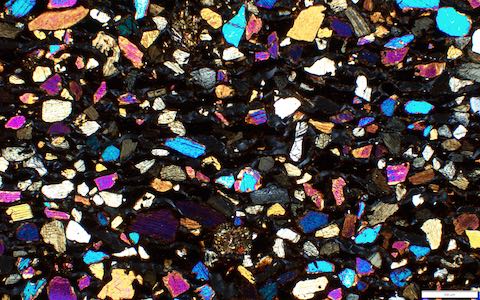
Sio style sherd. CAUTION: Section less than 30microns. Closely packed pyroxene grains are about 0.3 mm in length. There are some altered volcanic rock fragments and iron oxides. Small angular plagioclase grains are accessory.
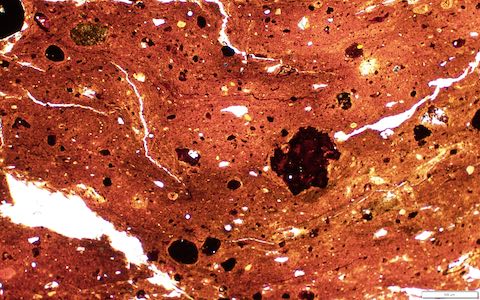
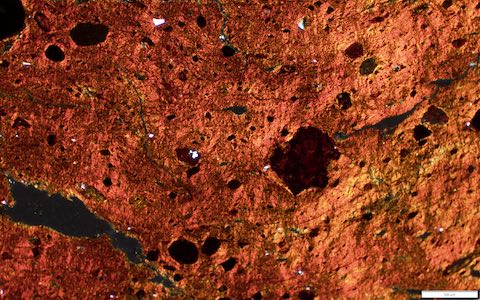
X style sherd. CAUTION: Section less than 30microns. This red brown sherd is characterized by sub rounded to rounded black clasts up to 2 rnn across and small amounts of quartz grains widely scattered through the sherd.
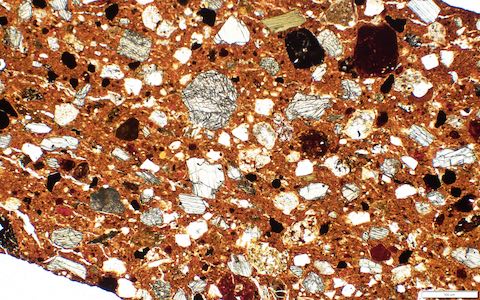
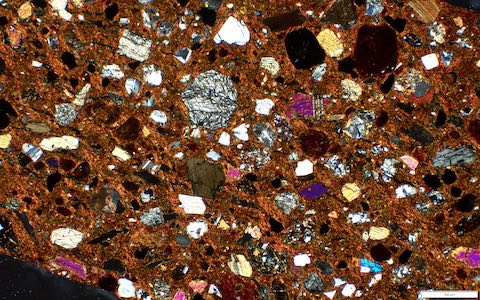
Madang style sherd. CAUTION: Section less than 30microns. Pyroxene and plagioclase grains are up to 0.3 mm in length. Magnetite grains are subrounded and elongate and less than 0.2 mm. Volcanic rock fragments are less than 0.2 mm in length. There are some minor quartzitic grains and red ferruginized grains. The clay is red brown and contains a small percentage of quartz and feldspar.
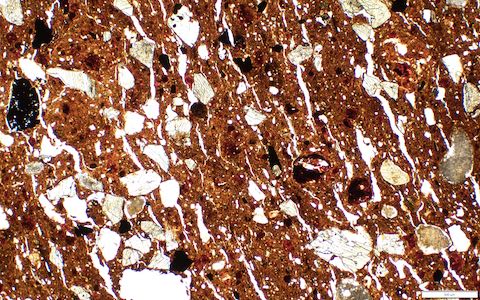
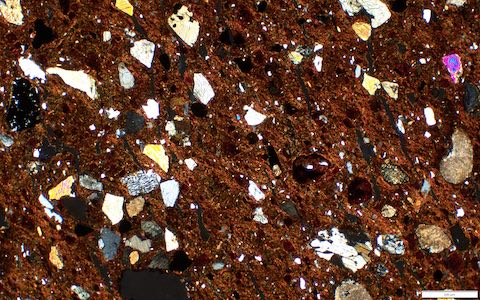
Madang style sherd. CAUTION: Section less than 30microns. Pyroxene occurs in grains up to 0.3 mm in length. Shelly fragments, are subrounded and less than 0.3 mm in length. Opaque minerals and black ferruginized grains are minor. There are some rock fragments containing pyroxene and plagioclase crystals, opaques and a trace of altered glass. Between these large grains there are abundant fine angular quartz grains.
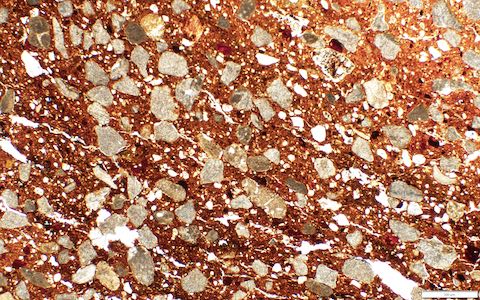
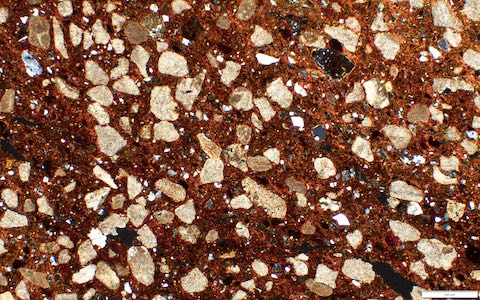
Madang style sherd. CAUTION: Section less than 30 microns. Shelly fragments are generally subrounded and about 0.2 mm across. Plagioclase grains are about 0.1 mm in diameter and there are abundant small quartz grains widely scattered through the sherd. Opaque minerals are minor and there are some red to black ferruginized clasts. Pyroxene is rare.
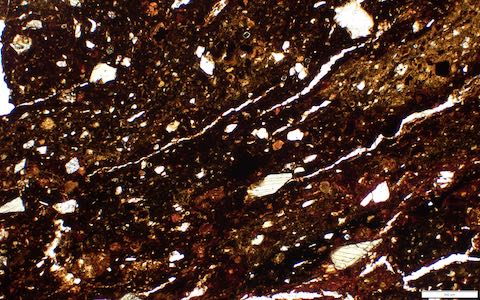
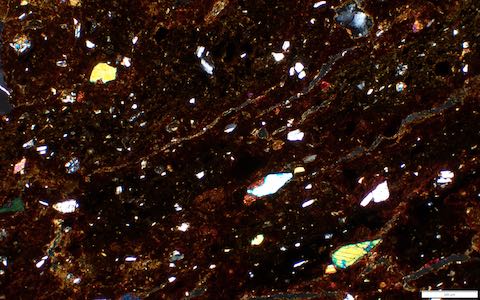
Sio style. CAUTION: Section less than 30microns. This dark red to black sherd contains abundant quartz and plagioclase up to 0.1 mm in length. There are some large pyroxene and volcanic rock fragments up to 0.4 mm in length but these grains are only accessory.
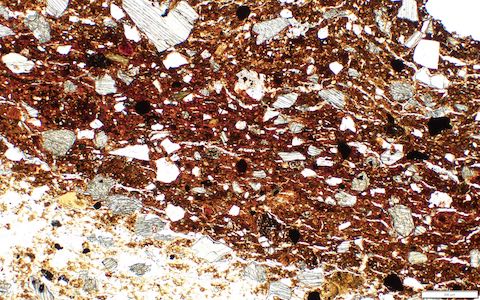
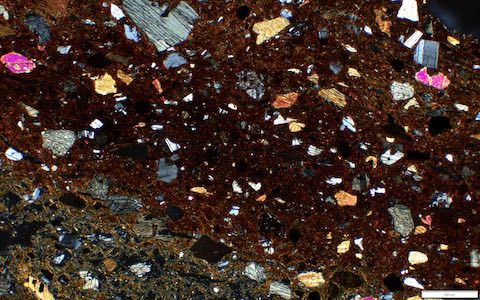
Sio style. CAUTION: Section less than 30microns. Pyroxene grains (<10%) are generally about 0.3 mm in length. Plagioclase grains (<5%) are less than 0.2 nm in length. There are some volcanic rock fragments, up to 0.7 mm across which are mainly composed of plagioclase laths, fine opaques and altered glass. This sherd also contains accessory iron oxides and red ferruginized grains.
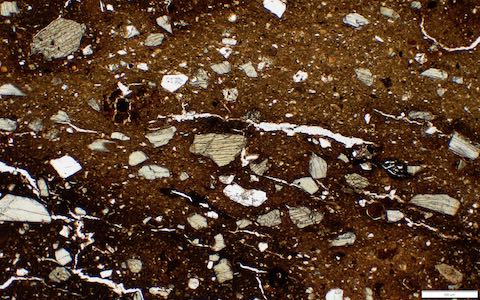
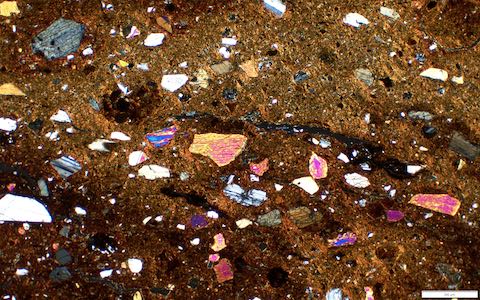
Sio style. CAUTION: Section less than 30microns. Pyroxene crystals are less than 0.5 mm in length and make up about 5% of the sherd. Plagioclase grains are less than 0.2 mm in diameter and make up less than 5%. There are also some volcanic rock fragments, ferruginized clasts and opaque minerals. The clay is dark brown.
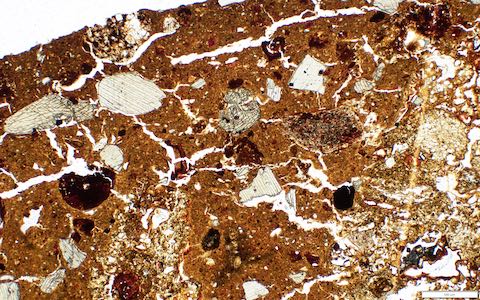
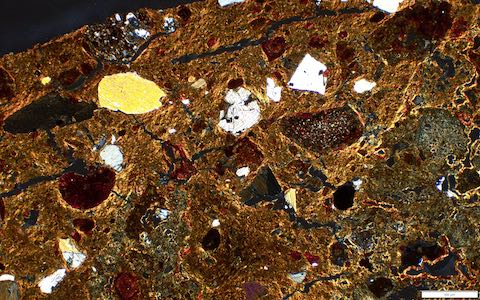
Sio style. CAUTION: Section less than 30microns. Pyroxene grains (<5%) are up to 0.5 mm in length. There are some large clasts more than 1 mm in length which resemble previous pot fragments. There are some red to black ferruginized grains and volcanic rock fragments. There is a small amount of fine grained quartz and feldspar in the brown clay.
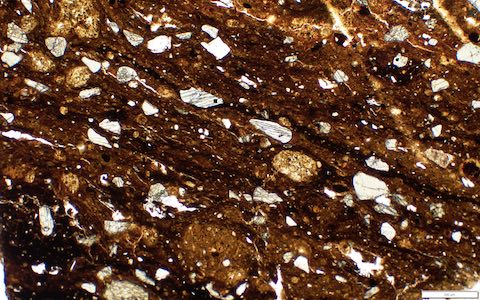
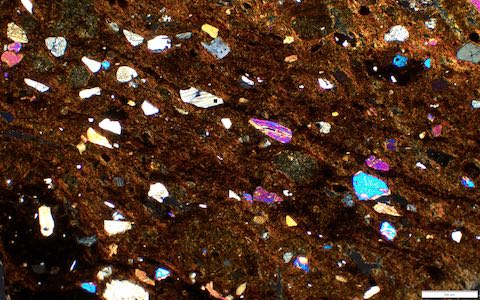
Sio style. CAUTION: Section less than 30microns. Pyroxene grains (<5%) are up to 0.3 mm in length. Red ferruginized clasts (<1%). Opaques and strongly altered volcanic rock fragments are accessory components. The sherd also contains less than 5% of fine grained angular quartz.

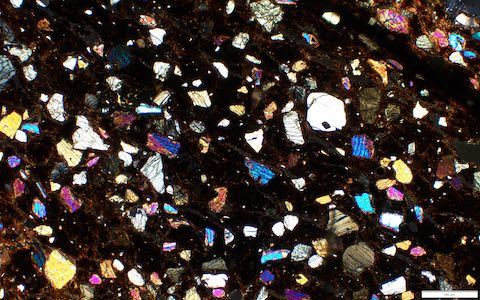
Sio style. CAUTION: Section less than 30microns. Pyroxene grains (10%) are generally less than 0.3 mm in length. There are several large (up to 0.8 mm) dark ferruginized clasts and minor weathered volcanic rock fragments and angular quartz grains.


Madang style. Paddle impressed. CAUTION: Section less than 30microns. Pyroxene grains (10%) range in size from 0.1 up to 0.7 mm in length. Quartz and feldspar grains (<10%) range from less than 0.1 up to 0.2 mm in length. There are some hypocrystalline volcanic rock fragments which contain large pyroxene crystals set in a ground mass of smaller pyroxene crystals, plagioclase, opaques and altered glass. The sherd also contains trace amounts of iron oxide and carbonate shell fragments.
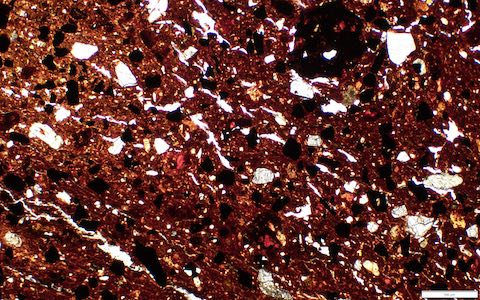
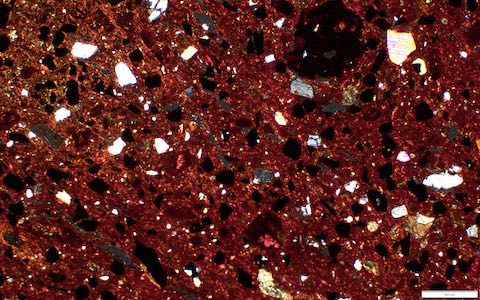
Madang style. CAUTION: Section less than 30microns. This sherd is characterized by angular to subrounded magnetite grains (5%) less than 0.2 mm in length. Pyroxene grains (1%) are less than 0.2 mm in length. Plagioclase grains (<1%) are generally less than 0.2 mm in length. But there are rare grains of quartz and feldspar up to 1 mm across. There are also trace amounts of red ferruginized grains and rare shell in the red clay.
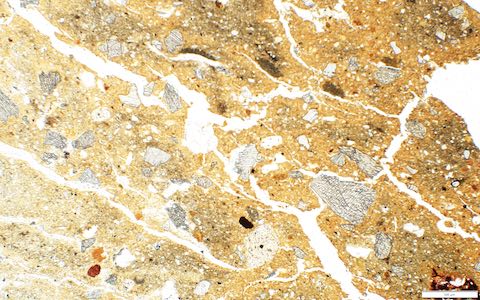
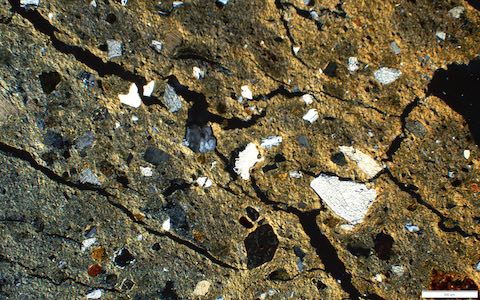
Sio style. CAUTION: Section less than 30microns. Pyroxene grains (<5%) are up to 0.5 mm in length. There are minor chert fragments, red ferruginized clasts and iron oxide grains. The clay is pale brown and contains abundant fine grained quartz and feldspar. Volcanic rock fragments are rare.
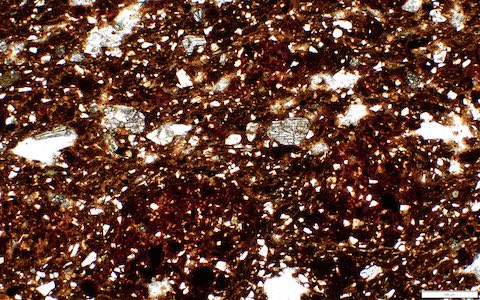

Sio style. CAUTION: Section less than 30microns. Pyroxene grains (<5%) are up to 0.3 mm in length. Angular quartz and feldspar grains make up about 10% of the sherd. These grains are generally small, <0.1 mm but range up to 0.2 mm. Opaque grains, (<5%) are subrounded and up to 0.4 mm in length. There are some minor rock fragments. The clay is red brown.
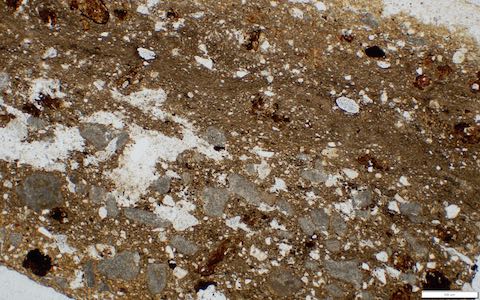
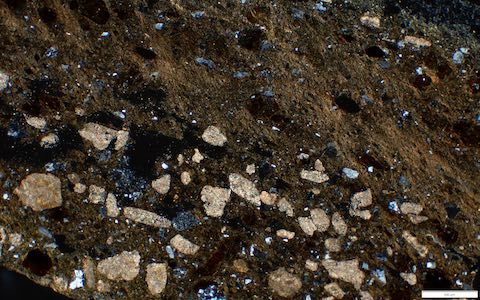
Madang style. CAUTION: Section less than 30microns. Subrounded shelly fragments up to 0.3 mm in diameter make up less than 10%. Quartz, chert and feldspar grains (<10%) are all less than 0.2 mm in length. There are some dark red-black ferruginized clasts up to 0.5 mm and the clay is brown.
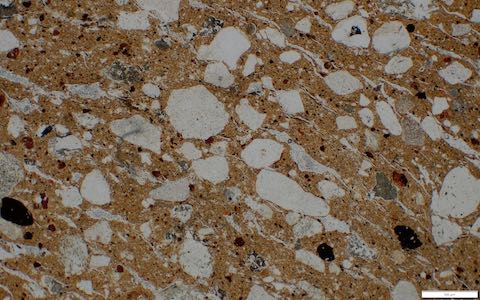
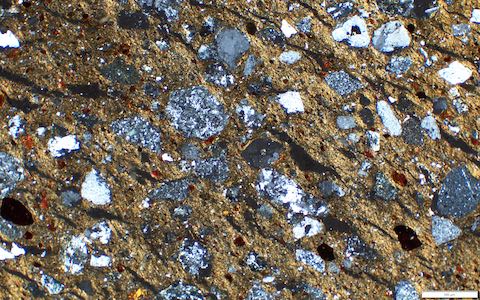
Madang style. CAUTION: Section less than 30microns. Angular feldspar and chert grains make up less than 10% of the sherd and are up to 0.4 mm in length. Volcanic rock fragments are found in two forms, one form consists of long thin plagioclase laths and skeletal iron oxides set in altered glass. The other form contains eutectic intergrowths of quartz and feldspar. The sherd also contains red ferruginized c lasts, iron oxides and minor pyroxene. The clay is red brown.
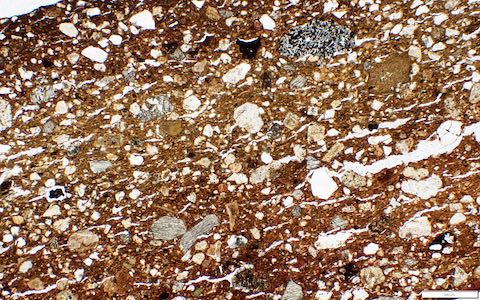
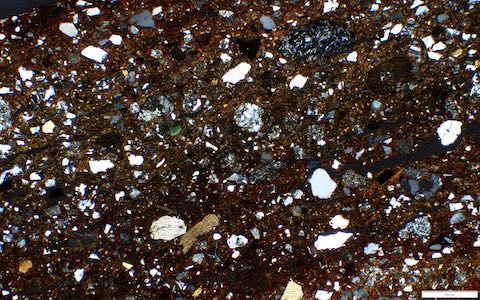
Madang style. CAUTION: Section less than 30microns. Quartz and plagioclase (about 10%) are less than 0.3 mm in length. There are some large volcanic rock fragments which contain plagioclase and pyroxene laths with minor iron oxide and also volcanic rock fragments which contain potash feldspar, plagioclase and quartz. Pyroxene grains are minor components and are up to 0.4 mm in length. There are also ferruginized clasts and iron oxides. The clay is red brown.
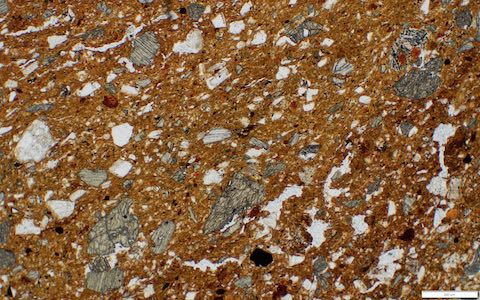
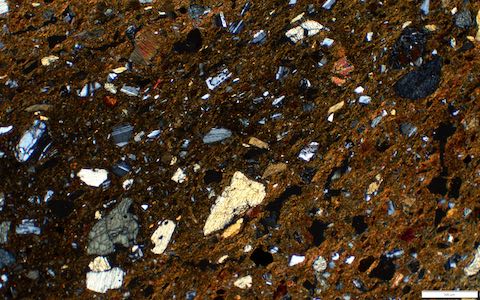
Pyroxene grains (10%).Quartz and feldspar grains (<10%). There are some hypocrystalline volcanic rock fragments which contain large pyroxene crystals set in a ground mass of smaller pyroxene crystals, plagioclase, opaques and altered glass. The sherd also contains trace amounts of iron oxide and carbonate shell fragments.